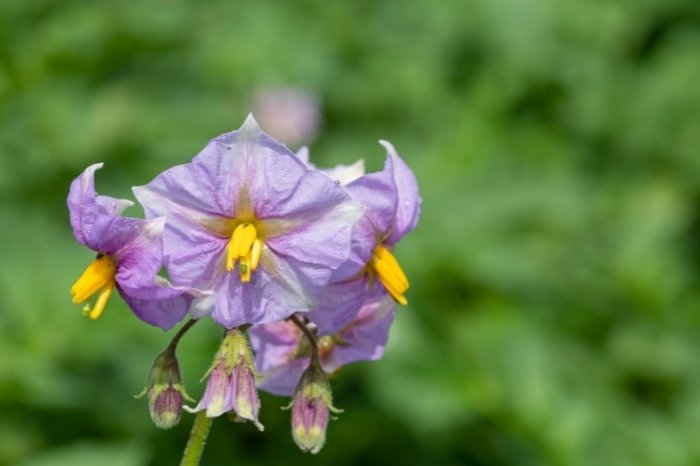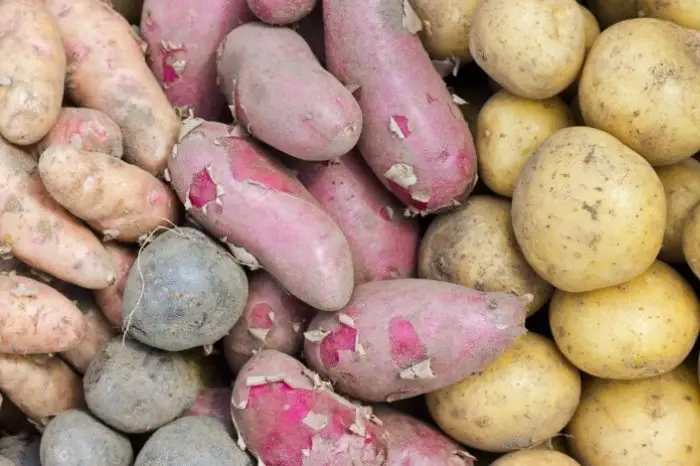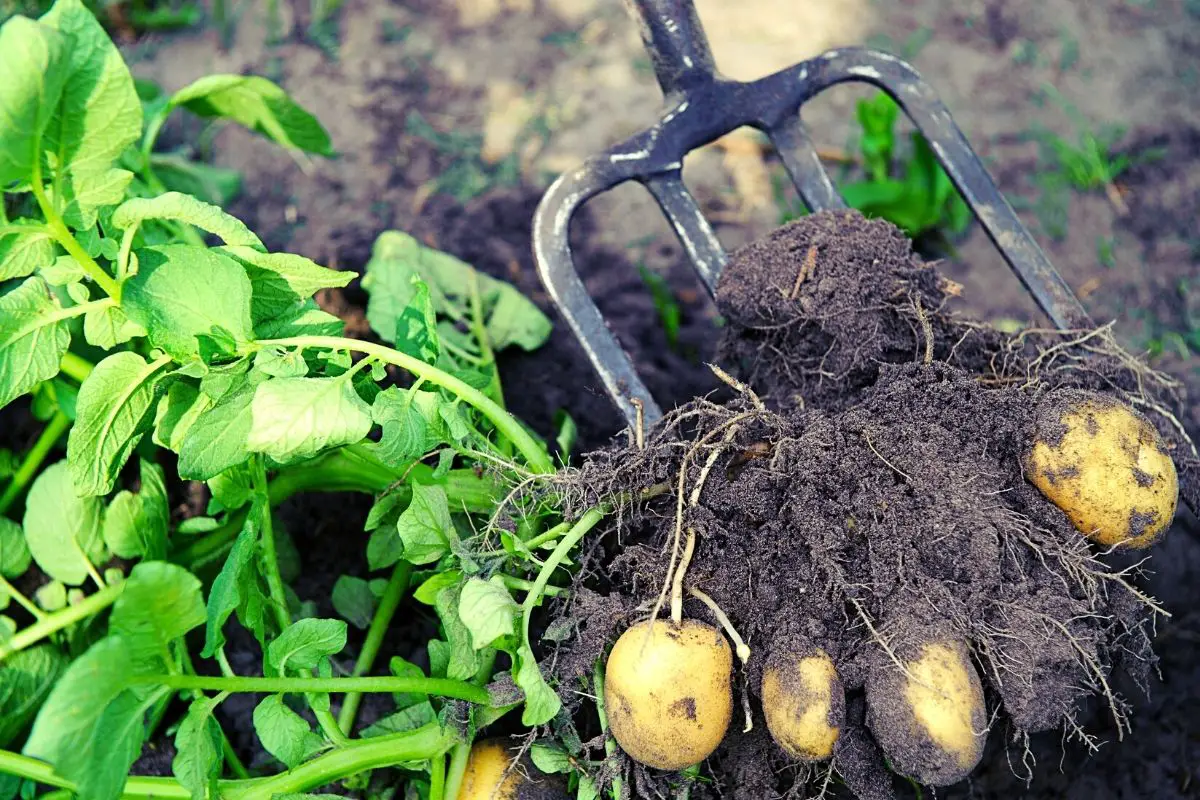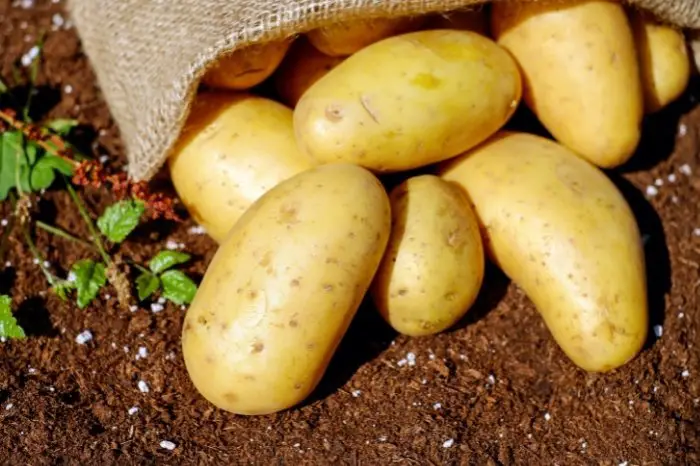Last Updated on February 14, 2023 by Griselda M.
We are often posed with the question, is a potato a root? Potatoes are one popular staple that we love to have in our dishes. It is even one of the most consumable foods worldwide. Potatoes are indeed inclined to grow underground, but are they root, stem, or fruit? What exactly are they? Are potatoes a root? Or are they stems? Let’s find out.
Usually, it may look like potatoes are roots because after all, they grow underground and most of the things that grow underground are termed roots. However, there is another belief that potatoes are stem. So, which one of these suggestions should we believe?
Well, we are all answering these questions in this post so continue reading to gain some insight into this question.
Is Potato a Root Crop
So, is a potato a root crop? The simple answer is no, potato plants are not root crops. What they are, are tuberous stems. What this means is that potato plants are nutrient-rich stems that grow underground. However, although they grow in the ground, they are not technically root crops. If we look at plants that fall under this category, they would include carrots, onions, garlic, beets, and some potato varieties, amongst others. Sweet potato is one of the root crop vegetables as opposed to tuberous varieties.
You would notice that when a potato tuber is planted, it usually will begin to produce shoot nodes that penetrate out of the soil. Thereafter, the potato plant roots will develop around the tuber, which gathers and stores nutrients. As this process progresses, the potato plant leaves will take up the nutrients to begin the process of photosynthesis. During this time, the plant roots become enriched with excess sugar, which turns into starch. Keep in mind that the tubers grow from underground stems that are known as stolons.
Are Potatoes Rhizomes?
I have often been asked the question, are potatoes rhizomes? Again, the answer is no, as potato plants are tubers and not rhizomes. This is evident in the nodes that potatoes produce on their tubers. These nodes can appear anywhere on the surface of the potato, and from it, you will witness the production of new roots and shoots as they develop.
Rhizomes, on the other hand, are a bit different in growth habits. This is because when they grow, their roots sprout at the base of the plant while their stems can be seen at the top. However, these fleshy underground stems or rhizomes, as they are commonly referred to, are not very much different from potatoes because they also grow in the ground and have growing points on their surface.
The most commonly grown rhizome plants include bamboo, ginger, canna lilies, and bearded Iris. The rhizomes in potato plants are commonly called stolons. Also, keep in mind that while tubers grow in any direction, rhizomes are horizontal growers.
Is Potato a Bulb
Is a potato a bulb? No, a potato is a tuber, as mentioned above, and not a bulb, as most people commonly think. A bulb plant that is often used in kitchens throughout the world is the humble onion. If you look at a variety of different plants, you would notice that a lot of them have corms, rhizomes, tubers, or bulbs that grow underground.
These parts of the plant are used to store nutrients in case they are difficult to access when climate and soil conditions deteriorate. So, mistaking potatoes for bulbs is understandable because of growth similarities. However, them apart is also quite easy because of their distinctions.
Just remember that potato plants are the most common edible tubers, while begonias and daylilies are non-edible tuberous varieties.
Potato Taproot or Fibrous Root
Is it a potato taproot or a fibrous root? Well, potato plants have a shallow fibrous root system that grows to about 24 inches in length. Because potato rooting is shallow, these plants find it difficult to extract nutrients and moisture that is deep within the soil. Taproots, on the other hand, are sometimes subdivided into tubers. These include plants like yams, beets, carrots, and other fleshy-rooted crops.
For this reason, it is essential to understand the distinction that potatoes and cassava, which are tubers, are quite different from root vegetables. Additionally, galangal and ginger, which are rhizomes, and shallots and garlic, which are bulbs, are also not root vegetables, although they are often thought of as such. Have a look at the points below to get a grip on how to identify taproots from fibrous roots.
Identifying a Taproot
- Tap roots grow downwards in a vertical position and are, therefore, straight tapering root systems.
- These roots have a distinctive center from which you would witness the growth of subsidiary rootlets.
- Dandelions, beets, and carrots are all taproot plants.
- Taproots grow deep into the soil and are usually anchored.
- The first roots to grow from a planted seed are taproots.
Identifying a Fibrous root
- The opposite of a taproot system is a fibrous root.
- The thin branching roots are known to emerge from the stem when the plant is growing.
- You will find that in ferns and monocotyledonous plants, fibrous roots are usually universal.
- The roots are made up of hairlike strands that are quite fine. When clumped together, they resemble a thick mat at the base of the plant.
- Fibrous roots are excellent mineral and water absorbers that aid in stabilizing the plant.
Are Potatoes a Root?
The straight-up answer is that a potato isn’t a root and a potato isn’t really a stem. So, what then is it?
Potato can be regarded as a modified stem known as a tuber. This tuber grows or develops from an underground stem that is known as a stolon. Then they act as storage for food or starch which is later used by the plant.
So, now that we have established that potato is a type of modified stem known as a tuber, let’s further look into what makes their tubers.
Why Are Potatoes Regarded as Tuber? Are Potatoes A Root?
So, biologically speaking, potatoes are tuberous stems and potato is that part of the stem that is swollen and grown underground. It is genetics that causes the swelling of the potato stem and swelling is caused by the accumulation of starch.
Once a plant begins to adapt to certain environmental conditions, modifications begin to occur on different parts of the plant. Now, we refer to this modification as geophytes.
These tubers are typically the swollen parts of a plant that develops to store nutrients for the entire plant. Then the stored nutrient can be utilized later by the plant. Hence, these modifications help facilitate perennation (this is the ability of plants to survive during unfavorable conditions or seasons).
Check Out What Is The Best Grow Bag Size For Tomatoes?
Why Do We Regard Potatoes as Stem and Not a Root?
We consider potatoes to be a stem mainly because their tubers consist of all parts of a typical stem. Now, these parts include terminals, axillary buds, nodes, internodes, pedicels, and petioles.
So, here we have explained how each of these parts functions:
1. Nodes
The node is the point where the stems, buds, and leaves, as well as other crucial elements of a plant, develop. Nodes are also helpful to plants in terms of facilitating the healing of a plant after injuries.
2. Internodes
Internodes are that point or zone that connects two nodes. Internodes help in promoting the transportation of food, water, as well as minerals between the nodes. Note that the larger the internodes, the plant, or the bigger the potato will be as in this case.
3. Petiole – Are Potatoes A Root?
The petiole is the stalk that connects the leaves and the nodes. They help promote the transportation of minerals and water to the leaves and food transportation from the leaves to other parts of the plants after photosynthesis.
4. Lateral Bud
The section that develops between the petiole and the stem is regarded as a lateral bud. Most times, lateral buds are usually dormant. However, they can develop into leaves, flowers, or stems.
Potato-Grow-Bag, 2 Pack 10 Gallon Felt Potatoes Growing Containers with Handles&Access Flap
5. Terminal Bud
The vertical growth of a particular plant is controlled by the terminal bud. The development of more buds is prevented by the terminal bud and this ensures a plant can grow vertically.
6. Leaves – Are Potatoes a Root?
The leaves are the primary organs that develop from the nodes. They are broad and thin structures that usually appear along the petiole and at the end of the petiole. The majority of leaves are green and this includes the potato leaves and which assist in transpiration, photosynthesis, and respiration.
Read More About What Is Fibrous Root System? 3 Surprising Examples
7. Pedicels
The pedicel is that part of the flower stalk that connects the flower to the stem of the plant.
8. Flowers – Are Potatoes a Root?
A flower is that part that promotes pollination as well as sexual production in plants. These flowers can come in various colors and they are located at the end of a pedicel.
Side Note: the type of potato being discussed above is the Irish potato (also called white potato). Therefore, the Irish potato is a stem tuber.

Sweet Potato: Is it a Root Tuber or Stem Tuber?
We have pointed out that it is an Irish potato that is known as a stem tuber. But what about sweet potatoes?
Although sweet potato and Irish potato share the same name (potato) and also belong to the same family: these two potatoes are however not both stem tubers. Sweet potatoes are root tubers while Irish potatoes on the other hand are stem tubers.
Differences between Irish tuber stems and sweet potato tuber root
Irish potatoes are grown from seed tubers. Then sweet potatoes on the other hand are grown from small seedlings that were developed from growing sweet potatoes and the seedlings are known as slips.
The root tubers of sweet potatoes are also modified roots and this serves as storage organs for the entire plant. Similar to the stem tubers of Irish potatoes, the root tubers of sweet potatoes also store food to be utilized for the future growing season. Then after a growing season, the sweet potato plant dies and develops new shoots in the subsequent season.
Another obvious difference between sweet potato and Irish potato is that sweet potato does not have nodes, internodes, and all other characteristics that make Irish potato a stem tuber.

Another good example of a root tuber is cassava.
Conclusion – Are Potatoes a Root?
The question: are potatoes a root has been answered. We have explained above that potatoes are stems or modified stems. So, we hope you have been adequately enlightened about this.
FAQs
Are potatoes vegetables or roots?
Potatoes can be regarded as vegetables because vegetables are any part of a plant that is edible. Specifically speaking, potatoes are a kind of root vegetables that are tubers.
Why is potato not a root?
Although potatoes tend to grow from underground and most things that grow from underground are referred to as roots, this isn’t the case for potatoes. So, potato is not a root, rather it is a type of modified stem.
Is a potato a root or a bulb?
Potatoes are neither a root nor a true bulb. But technically and specifically speaking, potatoes are stems or modified tuber stems. This means that the stems of potatoes have been genetically modified to bring about swelling and this swelling is the accumulation of starch.
Is potato is a root or fruit?
Potatoes are not a root but rather modified stem tubers. They are not also fruit either and this is because they grow from roots rather than flowers. But potato plants do produce inedible fruits that resemble a cherry tomato but these fruits are toxic.
Find more information about Is Potato is A Root Vegetable Or Not? Deep Analysis On The Potato Plant

Eunice is a gardener who loves to play in the dirt. She starts her day early in the morning, watering her plants and tending to her garden. She loves the smell of freshly cut grass and the feeling of sunshine on her back as she works. She‘s a master at creating beautiful flower arrangements and can often be found humming a tune as she tends to her plants. When she‘s not gardening, she loves to read books about nature and share her knowledge with others. Eunice loves gardening so much that she‘s even been known to talk to her plants!




